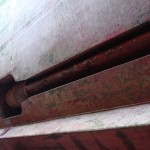Dry Docks – What to expect as a Deck Officer – Hull Cleaning & Blasting
Thursday, March 26th, 2015 at 06:00 | by Alistair BaillieBefore you read any further, please understand that I have only ever experienced Dry Docks onboard Passenger Ships and while there are many common activities that will occur the arrangements will be different, just as they will differ drastically between companies and even vessels within a company.
I have been lucky (or unlucky depending how you look at it) to experience 3 dry docks so far since qualifying, I was due to do one when I was a cadet but it was unfortunately cancelled. If you ever get an opportunity to do a dry dock while you are a cadet – jump at that chance, you can learn a lot which will help you out when you’re qualified.
For these next few blog entries I am going to concentrate on some of the common things that you may be involved in as a Deck Officer (particularly on passenger ships), of course there’s lots of other activities going on onboard involving the various departments as well and the points listed over the next few posts are not exhaustive.
In my experience on 3 different companies, normally the Deck Officers are assigned to supervise the various activities that are being carried out by the ship yard or other contractors with each officer being given a section of the vessel or an bunch of semi related tasks to keep an eye on, this usually means at least one will be assigned to keep an eye on the Hull Cleaning and Painting if it’s being carried out.
Hull Cleaning / Blasting
This will almost certainly take place, either as a precursor to repainting the hull or on its own. It’s usually one of the first things to take place once the ship is on the blocks and involves teams of dock workers with cherry pickers (or sometimes fancy scrubbing machines) using high pressure water to blast all the crap off the ships hull.
If all their doing is hull cleaning, its usually only water blasting that will be done to remove all the organic build up on the surface of the hull.
If the plan is to repaint the hull, after the initial spraying with water they will remove the paint. There’s different ways to achieve this but most probably they will use a mixture of sand and water to “grit blast” the hull (some ship yards only use high pressure water / air).
Just as there’s different ways to achieve the removal of the paint there’s different levels of finishing which are commonly named using the Swedish Standard SIS 05 59 00 as SA 1, SA 2, SA 2.5 and SA 3.
SA 1 – Is termed as Light Blast Cleaning, it basically removes loose rust, scale and foreign matter.
SA 2 – Is termed Thorough Blast Cleaning, it removes pretty much all scale, rust and foreign matter and the surface usually ends up a greyish colour.
SA 2.5 – Is termed Very Thorough Blast Cleaning, the only rust or paint left should be small stains or spots.
SA 3 – Is stripping back to the bare metal. All rust, paint and other foreign matter is removed completely leaving a clean and usually shinny metal finish.
As a Deck Officer your involvement is normally limited to recording the start / stopping times of each stage of the blasting and taking photos to show the extent of the blasting.
Disclaimer: I am not an expert on dry docking, this is intended purely as an informal guide of what to expect, if you want more details on any of the above, I suggest Googling key terms such as Sweedish Standard SIS…
To be continued…


